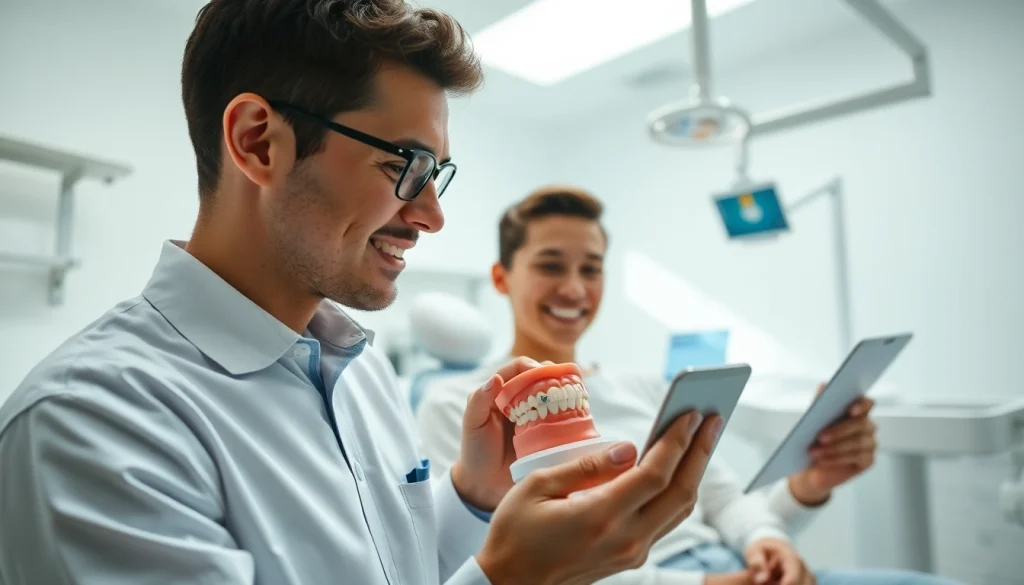
Understanding Orthodontics: An Overview of Treatments
What is Orthodontics and Its Importance
Orthodontics is a specialized field within dentistry focused on correcting misalignment of the teeth and jaw. This discipline plays a crucial role in improving not only the appearance of smiles but also the functionality of teeth and overall oral health. Traditionally associated with the use of braces, orthodontic solutions have evolved into various treatment options designed to meet the needs of patients of all ages.
Beyond aesthetic considerations, orthodontics is essential for ensuring proper bite alignment, which can prevent extensive dental issues in the future. Misaligned teeth can lead to difficulties in chewing, speaking, and maintaining oral hygiene—conditions that may ultimately affect a person’s quality of life. Seeking treatment from an orthodontist Myrtle Beach ensures that patients receive expert care tailored to their unique dental needs.
Common Types of Orthodontic Treatments
Orthodontic treatments are diverse, each designed to address specific issues. Some of the most popular types include:
- Traditional Metal Braces: These consist of metal brackets and wires that gradually shift teeth into proper alignment. They are highly effective for complex cases.
- Ceramic Braces: Similar to metal braces but made from tooth-colored materials, ceramic braces are less noticeable, appealing to patients concerned about aesthetics.
- Lingual Braces: Placed on the back of teeth, these offer a discreet option for those who want effective treatment without visible hardware.
- Invisalign: A popular alternative for adults and teens, Invisalign uses a series of clear, custom-made aligners to gradually move teeth without the need for brackets and wires.
How Orthodontics Can Impact Oral Health
The benefits of orthodontics extend far beyond aesthetics. Properly aligned teeth can significantly enhance oral health. Correcting overcrowding, gaps, or improper bite not only improves appearance but also facilitates easier cleaning, reducing the risk of cavities and gum disease. Furthermore, addressing jaw misalignment can alleviate discomfort, such as jaw pain and headaches, associated with temporomandibular joint disorder (TMJ).
Finding the Best Orthodontist Myrtle Beach Near You
Key Qualities to Look for in an Orthodontist
Choosing the right orthodontist is key to a successful treatment experience. Here are essential qualities to consider:
- Qualifications and Experience: Ensure that the orthodontist is board-certified and has years of experience treating cases similar to yours.
- Technology and Techniques: Look for an orthodontist who stays updated with the latest advancements in orthodontic care and technology.
- Patient-Centered Approach: A good orthodontist values patient input and provides personalized treatment plans and options.
- Positive Reviews: Patient testimonials and online reviews can provide insight into the quality of care and patient satisfaction.
How to Use Patient Reviews and Testimonials
Researching orthodontists online can offer a wealth of information through patient reviews and testimonials. These accounts often highlight the orthodontist’s communication style, ability to address concerns, and overall effectiveness in treatment. Yelp, Google Reviews, and other platforms are excellent resources for gathering this information. It’s also beneficial to ask friends or family for recommendations based on their experiences.
Consultation: What You Need to Ask
During your initial consultation, asking the right questions can help you gauge the orthodontist’s expertise and suitability for your needs. Consider inquiring about:
- All available treatment options, including their advantages and disadvantages.
- The estimated timeframe for treatment and any factors that may affect it.
- Insurance acceptance and payment plans.
- What to expect regarding follow-up visits and adjustments.
Costs and Insurance: Budgeting for Orthodontic Care
Average Costs of Orthodontic Treatments
Understanding the costs associated with orthodontic care is vital for budgeting effectively. The price of treatments such as traditional braces, clear braces, and Invisalign can vary significantly based on factors like complexity of the case, duration of treatment, and the orthodontist’s experience. On average, treatment costs may range from $3,000 to $8,000. However, it’s crucial to keep in mind that investing in orthodontic treatment can lead to long-term benefits for your oral health and confidence.
Understanding Insurance Coverage for Orthodontics
Many dental insurance plans offer orthodontic benefits, though coverage can vary widely. Inquire with your insurance provider to understand what aspects of treatment are covered, and whether there are any limits or exclusions. Often, plans may cover a percentage of the overall costs or provide a lifetime maximum benefit for orthodontic care.
Flexible Payment Plans for Families
To make treatment more accessible, many orthodontists offer flexible payment plans that allow you and your family to spread the cost of treatment over time. These plans can accommodate various budgets and often include no-interest financing options. It’s essential to discuss payment options during your consultation to find a suitable arrangement that ensures your family can prioritize their oral health without financial strain.
The Latest Innovations in Orthodontic Treatments
Invisalign: A Discreet Alternative to Braces
Invisalign has transformed the field of orthodontics, providing a discreet way for patients to achieve a straight smile. Using a series of custom-made plastic aligners, Invisalign allows for gradual movement of teeth without the discomfort associated with traditional braces. With the ability to remove the aligners while eating or cleaning your teeth, maintaining good oral hygiene becomes simpler. Furthermore, digital software enables precise treatment planning, allowing orthodontists to predict the results before starting treatment.
3D Imaging Technology in Orthodontics
3D imaging has revolutionized orthodontic diagnostics and treatment planning. Rather than traditional molds and X-rays, orthodontists can now use imaging technology to create detailed, three-dimensional representations of a patient’s dental structure. This innovation not only improves accuracy in diagnosis but also enhances patient communication regarding proposed treatment plans. Patients can view expected outcomes and understand their journey toward a straighter smile.
How Accelerated Orthodontics Works
For those seeking quicker results, accelerated orthodontics offers potential solutions. Techniques such as the Wilckodontics procedure use surgical methods to enhance the speed of tooth movement, typically reducing treatment time from years to months. Traditional braces or aligners can be employed in conjunction with these methods, allowing for effective and accelerated outcomes. However, this option should be thoroughly discussed with your orthodontist to ensure suitability for your individual dental needs.
Maintaining Oral Health During Orthodontic Treatment
Best Practices for Oral Hygiene with Braces
Maintaining oral hygiene during orthodontic treatment is vital for preventing cavities, gum disease, and other dental issues. It is essential to brush at least twice a day using fluoride toothpaste and to floss daily. Additionally, incorporating interdental brushes to clean between brackets and wires will help keep teeth and gums healthy. Regular visits to your general dentist for cleanings are also critical, as they can monitor your oral health throughout your treatment.
Managing Discomfort and Adjustments
Patients may experience discomfort, especially after initial placement of braces or after adjustments. Over-the-counter pain relievers can effectively manage this discomfort. Orthodontists often recommend soft foods for the initial days following adjustments, allowing your mouth to adjust to changes without causing pain. If discomfort persists beyond a few days or if you experience any unusual symptoms, contact your orthodontist for guidance.
Importance of Regular Orthodontic Follow-ups
Regular follow-up appointments with your orthodontist are crucial for tracking progress and making necessary adjustments. These visits ensure that treatment remains on schedule and that any issues are promptly addressed. Skipping appointments can lead to extended treatment time and may affect overall outcomes. Patients should prioritize these visits as part of their dental care routine.






